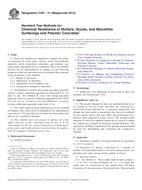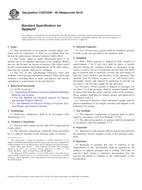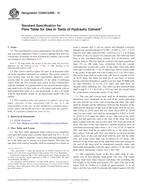We need your consent to use the individual data so that you can see information about your interests, among other things. Click "OK" to give your consent.
ASTM C267-01(2012)
Standard Test Methods for Chemical Resistance of Mortars, Grouts, and Monolithic Surfacings and Polymer Concretes
STANDARD published on 15.11.2012
The information about the standard:
Designation standards: ASTM C267-01(2012)
Note: WITHDRAWN
Publication date standards: 15.11.2012
SKU: NS-12746
The number of pages: 6
Approximate weight : 18 g (0.04 lbs)
Country: American technical standard
Category: Technical standards ASTM
The category - similar standards:
Annotation of standard text ASTM C267-01(2012) :
Keywords:
brick mortars, chemical-resistant, machinery grouts, monolithic surfacings, polymer concrete, resin materials, silica materials, silicate materials, tile grouts, ICS Number Code 91.100.10 (Cement. Gypsum. Lime. Mortar)
Additional information
| Significance and Use | ||||||||||
|
4.1 The results obtained by these test methods should serve as a guide in, but not as the sole basis for, selection of a chemical-resistant material for a particular application. No attempt has been made to incorporate into these test methods all the various factors that may affect the performance of a material when subjected to actual service. The strength values obtained by these test methods should not be used to evaluate the compressive strength of chemical-resistant materials. The appropriate ASTM test method for the specific material should be used for determining and evaluating the compressive strength. |
||||||||||
| 1. Scope | ||||||||||
|
1.1 These test methods are intended to evaluate the chemical resistance of resin, silica, silicate, sulfur, and hydraulic materials, grouts, monolithic surfacings, and polymer concretes under anticipated service conditions. These test methods provide for the determination of changes in the following properties of the test specimens and test medium after exposure of the specimens to the medium: 1.1.1 Weight of specimen, 1.1.2 Appearance of specimen, 1.1.3 Appearance of test medium, and 1.1.4 Compressive strength of specimens. 1.2 Test Method A outlines the testing procedure generally used for systems containing aggregate less than 0.0625 in. (1.6 mm) in size. Test Method B covers the testing procedure generally used for systems containing aggregate from 0.0625 to 0.4 in. (1.6 to 1.0 mm) in size. Test Method C is used for systems containing aggregate larger than 0.4 in. 1.3 The values stated in inch-pound units are to be regarded as standard. The values given in parentheses are mathematical conversions to SI units that are provided for information only and are not considered standard. 1.4 This standard does not purport to address all of the safety concerns, if any, associated with its use. It is the responsibility of the user of this standard to establish appropriate safety and health practices and determine the applicability of regulatory limitations prior to use. |
||||||||||
| 2. Referenced Documents | ||||||||||
|
Similar standards:
Historical
1.6.2011
Historical
1.8.2014
Historical
1.10.2010
Historical
15.7.2012
Historical
1.2.2010
Historical
1.6.2013
We recommend:
Technical standards updating
Do you want to make sure you use only the valid technical standards?
We can offer you a solution which will provide you a monthly overview concerning the updating of standards which you use.
Would you like to know more? Look at this page.



 ASTM C207-06(2011)..
ASTM C207-06(2011).. ASTM C219-14a
ASTM C219-14a ASTM C22/C22M-00(201..
ASTM C22/C22M-00(201.. ASTM C226-12
ASTM C226-12 ASTM C227-10
ASTM C227-10 ASTM C230/C230M-13..
ASTM C230/C230M-13..
 Cookies
Cookies
